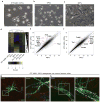Transcription factor-mediated reprogramming of fibroblasts to expandable, myelinogenic oligodendrocyte progenitor cells
- PMID: 23584611
- PMCID: PMC3678540
- DOI: 10.1038/nbt.2561
Transcription factor-mediated reprogramming of fibroblasts to expandable, myelinogenic oligodendrocyte progenitor cells
Abstract
Cell-based therapies for myelin disorders, such as multiple sclerosis and leukodystrophies, require technologies to generate functional oligodendrocyte progenitor cells. Here we describe direct conversion of mouse embryonic and lung fibroblasts to induced oligodendrocyte progenitor cells (iOPCs) using sets of either eight or three defined transcription factors. iOPCs exhibit a bipolar morphology and global gene expression profile consistent with bona fide OPCs. They can be expanded in vitro for at least five passages while retaining the ability to differentiate into multiprocessed oligodendrocytes. When transplanted to hypomyelinated mice, iOPCs are capable of ensheathing host axons and generating compact myelin. Lineage conversion of somatic cells to expandable iOPCs provides a strategy to study the molecular control of oligodendrocyte lineage identity and may facilitate neurological disease modeling and autologous remyelinating therapies.
Conflict of interest statement
P.J.T., R.H.M., and F.J.N. have a pending patent application for this technology.
Figures





Comment in
-
iOPs: a new tool for studying myelin pathologies?Cell Stem Cell. 2013 May 2;12(5):503-4. doi: 10.1016/j.stem.2013.04.021. Cell Stem Cell. 2013. PMID: 23642358
-
Neural repair and rehabilitation: Fibroblast-derived OPCs--hope for remyelination therapy?Nat Rev Neurol. 2013 Jun;9(6):299. doi: 10.1038/nrneurol.2013.85. Epub 2013 May 7. Nat Rev Neurol. 2013. PMID: 23649101 No abstract available.
-
White matter from fibroblasts.Nat Biotechnol. 2013 May;31(5):412-3. doi: 10.1038/nbt.2570. Nat Biotechnol. 2013. PMID: 23657393 Free PMC article.
-
Changing one cell type into another.Nat Methods. 2013 Jun;10(6):459. doi: 10.1038/nmeth.2500. Nat Methods. 2013. PMID: 23866329 No abstract available.
References
-
- Franklin RJ, Ffrench-Constant C. Remyelination in the CNS: from biology to therapy. Nat Rev Neurosci. 2008;9:839–855. - PubMed
Publication types
MeSH terms
Substances
Associated data
- Actions
Grants and funding
- R33 MH087877/MH/NIMH NIH HHS/United States
- P30CA043703/CA/NCI NIH HHS/United States
- F31 NS083354/NS/NINDS NIH HHS/United States
- T32GM008056/GM/NIGMS NIH HHS/United States
- K08 EY019880/EY/NEI NIH HHS/United States
- NS30800/NS/NINDS NIH HHS/United States
- MH087877/MH/NIMH NIH HHS/United States
- R01 NS030800/NS/NINDS NIH HHS/United States
- EY019880/EY/NEI NIH HHS/United States
- P30 CA043703/CA/NCI NIH HHS/United States
- R21 MH087877/MH/NIMH NIH HHS/United States
- F31NS083354/NS/NINDS NIH HHS/United States
- T32 GM008056/GM/NIGMS NIH HHS/United States
LinkOut - more resources
Full Text Sources
Other Literature Sources
Medical
Molecular Biology Databases
Research Materials

